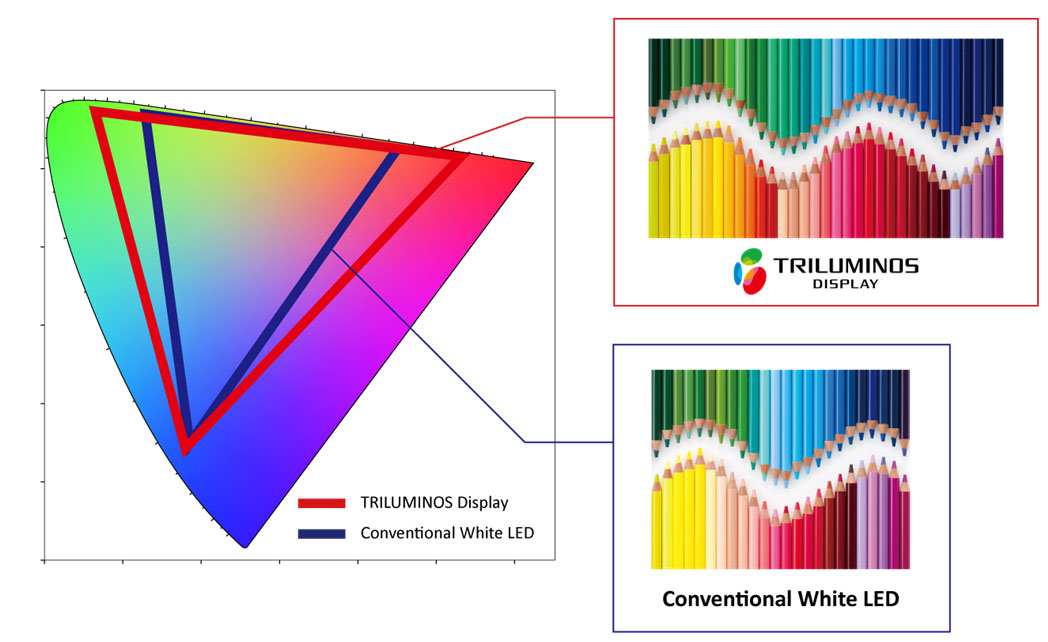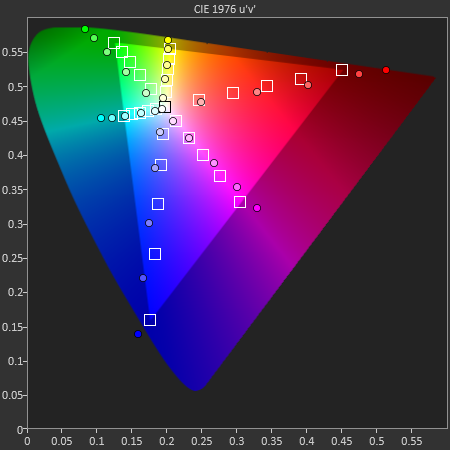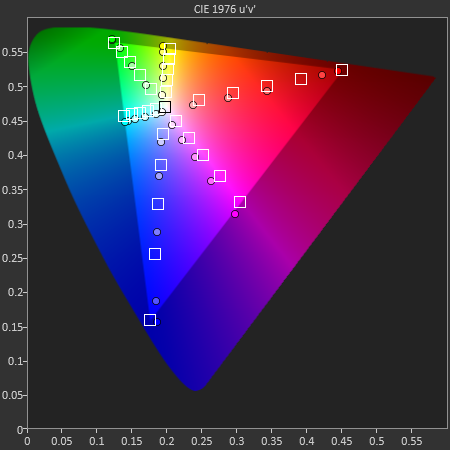Color Gamut in Smartphones: Why Bigger isn't Always Better
by Joshua Ho on March 3, 2014 9:22 AM EST- Posted in
- Displays
- Smartphones
- Mobile

Post-MWC, with the launch of at least two of the major high-end flagships in the smartphone space, the basics are becoming increasingly easier to get from OEMs like high DPI displays, the latest SoC, and a plethora of RAM. Therefore, other pieces of the smartphone become increasingly important. One of the most misunderstood parts of the smartphone is a display’s accuracy. Much of this can be chalked up to a lack of existing literature on the subject when it comes to smartphone display quality, which made it easy for subjective evaluation to be the rule.
Of course, even in the PC display space, good displays were incredibly rare because of the race to the bottom for cost. Because reviewers simply didn’t highlight display quality/calibration quality in any objective manner, PC OEMs could cut costs by not calibrating displays and using cheaper panels because people adapted to the color, whether it was accurate or not. The end result was that the early days of the smartphone display race were filled with misinformation, and it has only been recently that smartphone OEMs have started to prioritize more than just contrast and resolution.
Perhaps one of the greatest misconceptions in evaluating display quality is gamut. Many people associate larger gamut with better display quality, but taking this logic to the extreme results in extremely unrealistic colors. The truth, as always, lies somewhere in between. Too large or too small of a gamut makes for inaccurate color reproduction. This is where a great deal of the complexity lies, as many people can be confused as to why too large of a display gamut is a bad thing. This certainly isn't helped by marketing, which pushes the idea of greater gamut equating to better display quality.

The most important fact to remember is that all of the mobile OSes are not aware of color space at all. There is no true color management system, so the color displayed is solely based upon a percentage of the maximum saturation that the display exposes to the OS. For a 24-bit color display, this is a range of 0-255 for each of the RGB subpixels. Thus, 255 for all three color channels will yield white, and 0 on all three color channels yields black, and all the combinations of color in between will give the familiar 16.7 million colors value that is cited for a 24-bit display. It's important to note that color depth and color gamut are independent. Color gamut refers to the range of colors that can be displayed, color depth refers to the number of gradations in color that can be displayed.
Reading carefully, it’s obvious that at no point in the past paragraph is there any reference to the distribution of said colors. This is a huge problem, because displays can have differing peaks for red, green, and blue. This can cause strange effects, as what appears to be pure blue on one display can be a cyan or turquoise on another display. That’s where standards come in, and that’s why quality of calibration can distinguish one display from another. For mobile displays and PC displays, the standard gamut is sRGB. While there’s plenty to be said of wider color gamuts such as Adobe RGB and Rec. 2020’s color space standards for UHDTV, the vast majority of content simply isn’t made for such wide gamuts. Almost everything assumes sRGB due to its sheer ubiquity.
While it may seem that a display with color gamut larger than sRGB would simply mean that sRGB colors were covered without oversaturation, the OS’ lack of colorspace awareness means that this isn’t true. Because the display is simply given commands for color from 0 to 255, the resulting image would have an extra saturation effect. Assuming that the saturation curve from 0 to 255 is linear, not a single color in the image would actually be the original color intended within the color space, and that’s true even within the color space. This is best exemplified by the saturation sweep test as seen below. Despite the relatively even spacing, many of the saturations aren't correct for a target color space.

On the flip side, another issue is when the display is constrained to sRGB, but the OEM applies a compression of saturation at the high end to try and make the colors "pop", even though it too reduces color accuracy of the display, as seen below on all but the magenta saturation sweep.

Ultimately, such quibbles over color gamut and the resultant color accuracy of the display may not be able to override the dominant discourse of subjectively evaluated color in a display, and many people prefer the look of an oversaturated display to that of a properly calibrated one. But within the debates that will undoubtedly take place over such a subject, it is crucial to keep in mind that regardless of personal opinion on display colors, color accuracy is a quantitative, objective analysis of display quality. While subjectively, one may prefer a display that has a color gamut larger than sRGB, objectively, such a display isn't accurate. Of course, including a vivid display profile isn't a problem, but there should always be a display profile that makes for accurate color.










57 Comments
View All Comments
fteoath64 - Monday, March 3, 2014 - link
Josh, I think you are right but being very clinical about accuracy. Nothing wrong with that but worth noting as "over-saturation" of colours could be the preference for some. ie Being overaccurate becomes inaccurate because it veers outside the accurate line. This is not dissimilar to audio equalizer where the settings corrects the frequencies that matter to the person, thus closing in on the preference. Maybe the preference is 10% over pure accurate but that would be ok as it is a preference. Only for PRO work do people quest for acuracy. In normal cases, preference typically overrides everything else. Colors popping out for AMOLED displays attracted many fans while some just got a srong turn-off. It is preference at play!.If you look at the Mac screen with its colour calibration, many people prefer a slight blue tint rather than a brownish gray tint that is more accurate for the display.
bradleyg5 - Tuesday, March 4, 2014 - link
sRGB is NOT a stardard all display manufacturers, all OS creators, all printers, all content creators adhear to. sRGB is the most common and in a lot of instances assumed, but you can't just go around calling every display that doesn't come out of the box calibrated for sRGB innaccurate.You mean to say large gamut displays tend to display sRGB content innaccurately.
emn13 - Tuesday, March 4, 2014 - link
Is that really the case, though? Calibration focuses on absolute color accuracy, and while that's an impeccable standard, it's not really close to how human vision works - a more lenient standard can be perceptually better in fact, by exploiting the fact that the white balance of the device (for instance) should be approximately equal to its surroundings.Furthermore, although you can more "accurately" display sRGB images if correctly profiled, you can be almost positive that most images aren't intrinsically sRGB; they're just produced in the most common color space. The sRGB representation isn't necessarily the most accurate representation of the underlying conceptual image; it's just all you have. If the underlying image had out-of-gamut colors (quite likely, given how small sRGB is), then most imaging software/hardware will choose to introduce saturation errors, rather than the more disturbing hue errors, and so simply rendering the image in an enlarged gamut may in fact be *more* accurate.
The point is, you want to achieve something that looks good & realistic. If you follow sRGB precisely, you're safe that you know you'll be OK. But you're being accurate to the *representation* not necessarily the original photographic subject and/or artistic intent, and *that's* what actually matters.
The fact that people routinely oversaturate sRGB images is an indication that sRGB is simply too small.
As an analogy: sRGB color accuracy is to color quality as a microbenchmark is to a real power-hungry workload. It's a useful and illustrative, but it's *not* the ultimate aim.
makruiten - Thursday, March 6, 2014 - link
I think it's clear that the author doesn't imply that sRGB as a standard is the most accurate choice. Rather, he says that sRGB is the most widely used color space and that therefore any OS without color awareness and a too large color gamut will wrongly display most of the available content. And this is especially true for a mobile OS, since most content is on the web. I'm all in for larger gamut displays with proper color management and I'm sure the author of the article is too. Let's all make the shift.quickbunnie - Monday, March 3, 2014 - link
This is a good article, and you explain why wide color gamuts become inaccurate under improper constraints (saturation compression) or no constraints. However, isn't the solution to simply use proper constraints (ie no saturation compression) during calibration? I believe the galaxy note 3 does this using its movie mode.If you want to use vanilla Android with no color profiles, then yes, you don't want a wide gamut calibration (and thus obviate the need for a wide gamut display).
But I agree with the comments of other users that the solution isn't to keep using sRGB gamuts, as this will never improve the gamut that we use. Instead, the solution is to have wide gamut technologies that are properly calibrated to sRGB, and can switch to a wider colorspace when the on-screen content encodes for it (such as viewing Adobe RGB photos). Otherwise, we will forever be limited to colorspace ignorant OS'es and be tied down to the dull sRGB colorspace.
jordanclock - Monday, March 3, 2014 - link
The article explains this in that Android does not have any kind of built-in color control. What this means is that if the display has too wide of a color gamut, the OS isn't aware of this. This causes colors sent by the OS to the display to differ, since the OS doesn't know its idea of "dark blue" or "bright green" are different from the displays spread of colors.Basically, it's like telling someone coordinates on a map, but their map has wider units on the X axis and shorter units on the Y axis.
lilo777 - Monday, March 3, 2014 - link
The device can take care of it by providing several display modes. As I understand, in this case the device would change driver settings so that in certain modes the driver uses only a segment of the gamut. This way user may chose to do a sRGB gamut (available on most phones like iPhone) or a wide gamut.fteoath64 - Monday, March 3, 2014 - link
Yes, I agree with Lilo777. It does seem the display will ditter/spread the colour depending on its mode. It is not great but better use of the wide gamut. Let's us hope Android gets the colour support fully to make good use of the brilliant screen soon.editorsorgtfo - Thursday, March 6, 2014 - link
An easy means to see why this is important is to find an Anaglyph Video (perhaps on YouTube) and watch it on your PC, make certain it has reasonable color and most importantly no ghosting.Next watch the same Video on your Cellphone - ouch !
Krysto - Monday, March 3, 2014 - link
But from what I understand that doesn't have much to do with the fact that the display has wider gamut per se - just that OEMs tend to screw with the wider gamut to make it "pop" or they don't try to make it accurate enough.But assuming they do keep the colors accurate, isn't a wider gamut preferable - even if CURRENT content doesn't support it? Isn't that how progress happens? Maybe we ought to have a "retina moment" for color gamut, too, while sRGB is the "old standard"?
Unless you're saying sRGB is "more than enough for the human eye", but I don't think that's quite true, is it?